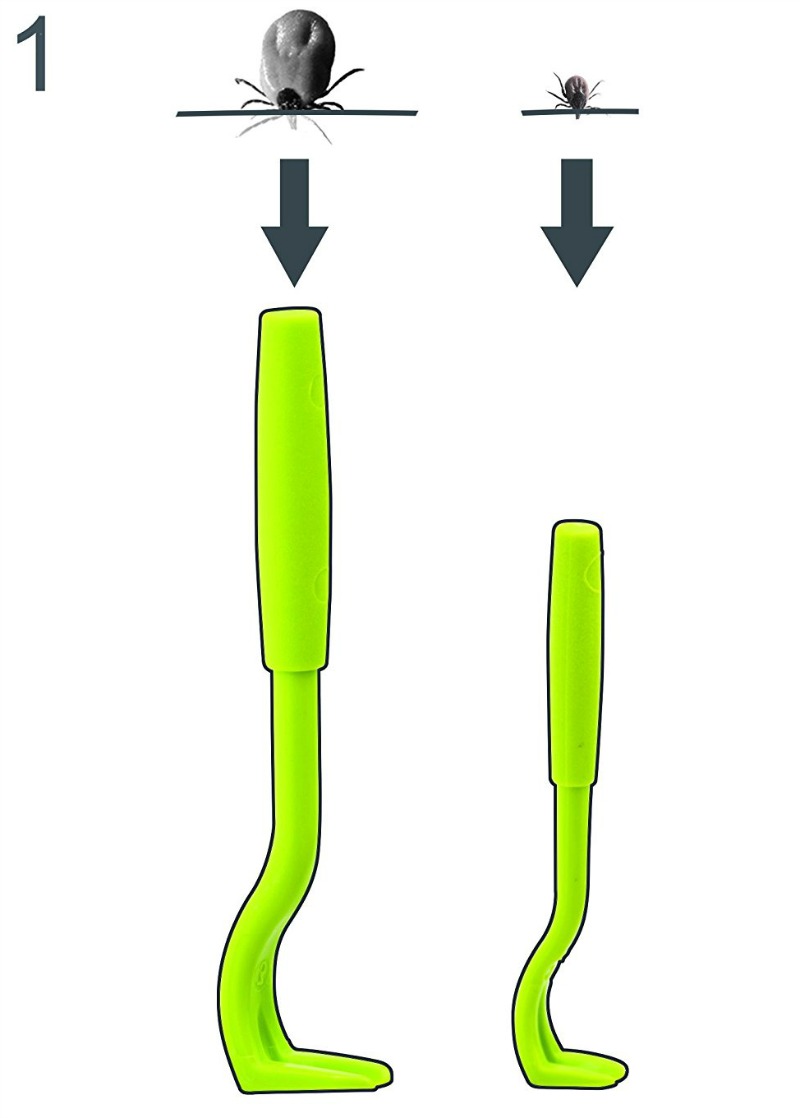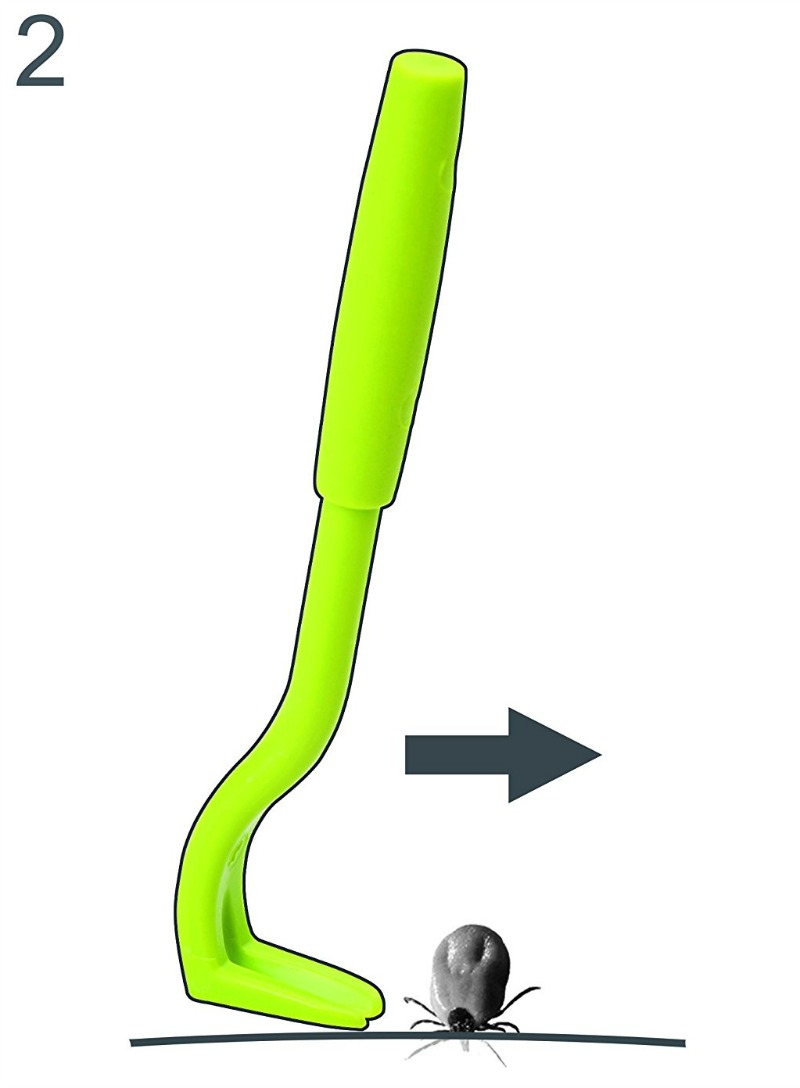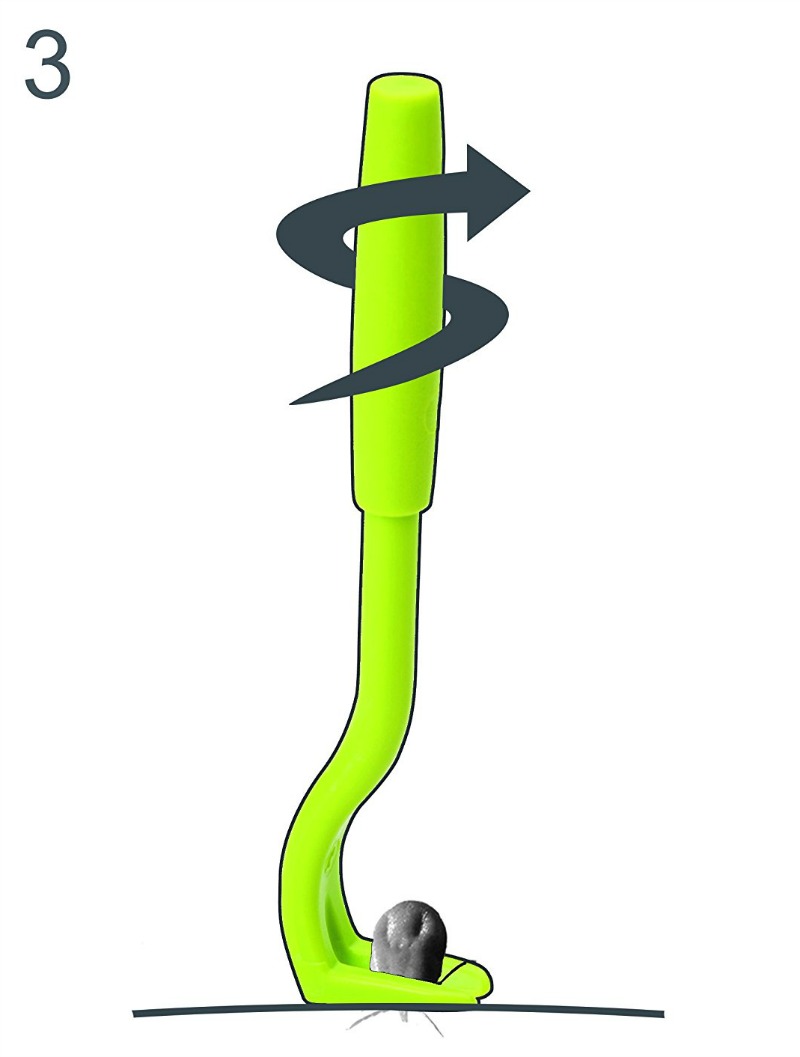Safe method to remove a tick without leaving the head stuck in the skin that works with small or large ticks and is easier than tweezers.

Each spring and summer, warmer weather and spending more time outside and camping outdoors increases the chances of exposure to nasty tick bites. The question is not “if” but “when” it will happen. And, when it inevitably does, how to remove a tick safely to minimize the chances of disease?
I have a friend who lives on a farm in Kentucky with his wife and five children. During tick season, he and his wife perform tick checks every night on all their children right before bathtime. They take ticks very seriously in their home because the Lyme disease carrying kind are very prevalent in their area.
It’s not just Lyme disease that is a potential risk either. The Journal of General Internal Medicine published an article by Susan Wolver, MD, and Diane Sun, MD, which identified a rising trend of red meat allergies from tick bites.
When one of my children was a fairly young baby and not even mobile yet, a tick lodged itself into the top of his head. Most likely, the tick dropped out of a tree onto his head, so don’t think your children are safe just because they aren’t hiking in the woods or walking in the grass!
If you discover that your child or pet has a tick that has lodged itself into the skin, here is the safest, easiest and quickest way to remove it.
How to Remove a Tick Safely and Quickly
The best way to remove ticks is using tweezers according to most authoritative sources. However, there is a new gadget called the tick twister remover that works even better.
My friend in Kentucky says that they used to use tweezers, but the tick twister is far superior and easier to use. It can be used to remove ticks from both pets and people.
Each tick twister tick removal set (it only costs about $6) has two removers inside: one large and one small. The different size is to allow for safe removal of both small and large ticks.
This ingenious device created by a veterinarian to safely remove ticks regardless of a person’s expertise has the following benefits:
- It is easier to use than tweezers especially for small ticks.
- It removes the tick without squeezing it, which greatly reduces the chances of disease transmission.
- It ensures the head and mouthparts of the tick are removed along with the body.
- It can be used for both large and small ticks.
Every home with children and/or pets should have one of these! It should also be included with camping equipment.
Safe Removal Steps. Better than Tweezers!
There are three steps for removing a tick using the tick twister.
First, you select which tick twister to use. If the tick is large, use the larger tick twister. If the tick is small, use the smaller one. Pretty simple!

Second, you grasp the tick between the head and body using the hook end of the tick twister. The picture below shows how to do it.

Third, simply twist the tick twister gently to easily and safely remove the entire tick out of the skin. That’s it!

After removing the tick, thoroughly clean the affected skin with alcohol. If there is any irritation, a dab of this herbal salve does wonders to quickly heal the skin.
Warning About some Tick Removal Recommendations
Some sources recommend pulling a tick straight out of the skin as the best method of removal.
This is very dangerous advice, because trying to pull a tick straight out will almost ALWAYS result in the head staying stuck in the skin. This is because ticks frequently lodge into the skin at an angle. They don’t usually burrow straight in perpendicular to the skin’s surface.
If you must use tweezers because you don’t have the tick twister remover available, be sure to pull the tick out at the same angle it went in.
This will give you the best shot at removing the head along with the body. In other words, grab the tick very firmly and close to the head as you can and pull out on a straight line but the same angle it burrowed in. I hope this makes sense.
It’s a little difficult to describe in words. This is the method taught to me by my Dad, who is a retired family doctor. Using this method, I’ve never left a tick’s head in the skin of any pet or person in over 40 years.
Of course, using the inexpensive tick twister is the best method of all. You don’t have to worry about angles – you simply twist the tick out of the skin!
How to Repel Ticks
This article describes the method for preparing an herbal yarrow tincture which is very effective at repelling ticks so you don’t have to remove them in the first place.
You ideally need to spray yourself every 2 hours or so.
Note that yarrow has been reputedly found by the US Army to be as effective as DEET in repelling ticks.








I recently tried a method that I read about and it did work. Soak a cotton ball in isopropyl alcohol and it will smother it as well.
Teresa, please read my posts and others that explain why this can make you very sick. It is not the right method for tick removal. I posted links that have great instructions, from tick experts.
Actually, the ticks with the white spots on their backs are Lone Star Ticks (Amblyomma americanum): http://www.tickinfo.com/lonestartick.htm
Deer ticks have a circular dark spot above their mouthparts: http://www.tickinfo.com/deertick.htm
Both can carry Lyme disease, however, and other diseases.
I’ve never heard of the soap method before, but I’ve heard that applying alcohol (or esp. a hot match) can make them regurgitate – which you definitely don’t want! I’ve always gently pulled them straight out. If the head gets left in just treat it with alcohol every day. The body usually works the mouthparts out. You still want to keep a close eye on it though.
Not saying the the old timers are wrong on this one, but they are sometimes! 🙂 Thanks for the article!
Phacelia, you are absolutely right that applying ANYTHING to the tick may make it regurgitate. Please read my post farther down the page. Folks, stop with the alcohol, hot pins, matches, etc. You are making it more likely that the tick will transmit disease. Don’t turn the tick over. Don’t do anything to make it detach itself. You want to remove it yourself, and not make it remove itself. Puking gut contents into the bite wound in order to detach can very well transmit disease.
Yes!!! I have heard this from numerous sources!!! They puke inside of you and then you have a much greater risk of getting a disease!!! Just pull them off you!!!
Actually, Ticks only carry Lyme in their Nymphal stages. In this stage, they are about the size of a pinhead and a pale skin toned color. Most time you don’t seen see them if you are bite by a nyphal tick.
Actually, that is not quite correct. Deer ticks (also called black-legged ticks) are very unlikely to carry Lyme disease, or any disease, in the larval stage, which is the first stage of life, when they are about the size of a grain of pepper. They are not light colored, but rather dark. Google for tick identification images and look at photos to see what they look like. They have six legs in the larval stage. They have not fed yet, so are not likely to carry disease, but it’s still good to get any tick off ASAP, without fooling with it. Deer tick larvae almost always feed on mice, which are the main reservoir of Lyme disease. That first feeding can make the tick infective, and it stays infective for life.
The nymphal stage is larger, but still very small, and dark colored. They can be infective. So can adult deer ticks, which tend to feed on deer, humans, and other large animals.
You can see all life stages of deer ticks if you look over every inch of your body, using a mirror or family member to check areas you can’t see directly. They would be harder to see on dark skin, easy to see on light colored skin. You can also feel them with your fingertips, usually. Some of us who are allergic feel tick bites immediately with a strong burning itch, which is nice since the sooner you get them off, the safer you are from infection.
Sorry – you don’t have your facts straight. In my area of New Hampshire, around 30% of nymphal ticks carry Lyme, and about 70% of adult ticks carry it.
You can see the nymphs, but yes, they are harder to spot. That’s why they are often considered more likely to transmit – failure to detect.
Here are two other methods of removing ticks I recently read on a Swiss website: one is cover the tick with a blob of lard, it will suffocate the tick and another method is to soak a cotton ball in iodine tincture, keep it down over the tick until the it falls down.
Yes! I grew up in the woods with lots of tall grasses, tons of deer and ticks! We always used lard, or if desperate (at a house where they had no lard) petroleum jelly. The tick backs right out within seconds and you wipe it way really easily! I actually did this recently and all that was on my skin was a small indent where the tick had been.
Aubrey, please read the comments. You are endangering yourself when you do this, greatly increasing the chance that the tick will transmit disease, because it will regurgitate some of its gut contents in order to detach itself. The disease organisms stay down in the gut several hours after a tick attaches; they are not transmitted right away. Do you want them injected into your body? Please read the comments on how to safely remove a tick, instead of making it detach.
Hmmm… Seattle Children’s Hospital actually recommends the liquid soap method that you listed, so I think Snopes may be wrong on all accounts.
Good to know!!!
After having so many ticks on our children, a friend of ours recommended Ticked Off. She hikes the Appalachian Trail every year and deals with ticks frequently herself. It is really easy, too, and supposedly also removes the head too.
http://www.tickedoff.com/
I use Ticked Off and the Tick Key. They both work the same way, more or less, and work well. But in tight spots, like between a dog’s or human’s toes, you need something like tweezers. Fine-pointed tweezers can get down and grasp the head so you can pull the whole tick off. I haven’t left mouthparts attached in years, I believe.
Or you could try the cotton ball with soap in tight spots like she suggested 😉
Awesome tip! We live in an area where having a tick latch on happens to at least one member of my family each summer. It’s great to know this trick.
Would you always recommend taking the spotted tick to dr. Our drs here would think I was crazy. Every year I pull off at least one or two with a spot. We have lots of deer in our woods-never really thought about the chances of getting tick fever.
Growing up my mother would always just “save” the dead ticks in a plastic bag for awhile. So if we developed any symptoms, then she would take us and the tick to the doctor (though I don’t remember ever having to do that.)
Another thing that I’ve heard recommended is to put the tick in a ziploc baggy and put it on your refrigerator for a couple of weeks. Should a bullseye show up on the bite location or some other troubling symptom appear, then take both yourself and the tick to the doc immediately. HTH with a possible alternative.
Thanks so much for this post. I have been really worried about ticks when we are at our farms. Now I know exactly how to deal w/ it if that ever happens. There are great homeopathic remedies (like ledum) for tick bites that we have on hand too. Great post! Thanks again.
Actually, I’ve never had trouble before with ticks despite living next to the woods. Sounds like a pretty good method to use. Using tweezers is actually a bad idea for other potential outdoors hazards, too, like splinters since the tweezers almost always leave in a little bit of the object or bug.
Definitely going to try this method the next time I find a tick on the dogs, or me!
I have a method that works pretty well – I twirl the tick round & round until it gets annoyed & backs out on its own. Then I take it & smother it in liquid soap. This works pretty well on the dogs. When I found one on myself, I tried it, but didn’t have the patience to let it work, because I was freaking out that there was a tick on me!! So I just yanked that one. Fortunately it wasn’t very deep, so the head came out with it.